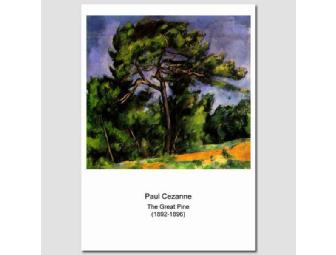EXTREME BARGAINS!
v-"The Great Pine" by Paul Cezanne (1892-1896)
- Item Number
- 1692
- Estimated Value
- 100 USD
- Opening Bid
- 15 USD
Item Description
Details of this item
"The Great Pine" by Paul Cezanne (1892-1896)
Master Artist Museum Print
Size: 11.7" x 16.5"
Status: Unframed
About the Artist
Paul Cezanne was born January 19, 1839, in Aix-en-Provence. His father, Philippe Auguste, was the cofounder of a banking firm that prospered throughout the artist's life, affording him financial security that was unavailable to most of his contemporaries and eventually resulting in a large inheritance. In 1852 Paul Cezanne entered the Collège Bourbon, where he met and became friends with emile Zola. This friendship was decisive for both men: with youthful romanticism they envisioned successful careers in the Paris art world, Cezanne as a painter and Zola as a writer. Consequently, Cezanne began to study painting and drawing at the ecole des Beaux-Arts in Aix in 1856. His father opposed the pursuit of an artistic career, and in 1858 he persuaded Cezanne to enter law school at the University of Aix. Although Cezanne continued his law studies for several years, he was simultaneously enrolled in the School of Design in Aix, where he remained until 1861.
In 1861 Cezanne finally convinced his father to allow him to go to Paris. He planned to join Zola there and to enroll in the ecole des Beaux-Arts. But his application was rejected and, although he had gained inspiration from visits to the Louvre, particularly from the study of Diego Velázquez and Caravaggio, Cezanne experienced self-doubt and returned to Aix within the year. He entered his father's banking house but continued to study at the School of Design.
The remainder of the decade was a period of flux and uncertainty for Cezanne. His attempt to work in his father's business was abortive, and he returned to Paris in 1862 and stayed for a year and a half. During this period he met Monet and Pissarro and became acquainted with the revolutionary work of Gustave Courbet and edouard Manet. Paul Cezanne also admired the fiery romanticism of Eugène Delacroix's paintings. But he was never entirely comfortable with Parisian life and periodically returned to Aix, where he could work in relative isolation. He retreated there, for instance, during the Franco-Prussian War (1870-1871).
One day, Cezanne was caught in a storm while working in the field. Only after working for two hours under a downpour did he decide to go home; but on the way he collapsed. He was taken home by a passing driver. His old housekeeper rubbed his arms and legs to restore the circulation; as a result, he regained consciousness. On the following day, he intended to continue working, but later on he fainted; the model with whom he was working called for help; he was put to bed, and he never left it again. He died of pneumonia a few days later, on 22 October 1906 and was buried at the old cemetery in his beloved hometown of Aix-en-Provence.
Item Special Note
shipping and handling: $29.95
NOTE: SHIPPING AND HANDLING COSTS ARE INCLUDED IN THE BUY NOW PRICE!!
Museum Prints
Our "Museum Prints" selection includes works from artists such as Edgar Degas, Odilon Redon, Rembrandt, Pierre Auguste Renoir, Hieronymus Bosch, Henri Rousseau, Peter Paul Reubens, Sandro Botticelli, Egon Schiele, Georges Seurat, William Bouguereau, Vincent Van Gogh, Mary Cassatt, Paul Cezanne, Francis Bacon, Salvador Dali, William Blake, Juan Gris and Philip Guston.
Donated By:
ART+more4Good stores data...
Your support matters, so ART+more4Good would like to use your information to keep in touch about things that may matter to you. If you choose to hear from ART+more4Good, we may contact you in the future about our ongoing efforts.
Your privacy is important to us, so ART+more4Good will keep your personal data secure and ART+more4Good will not use it for marketing communications which you have not agreed to receive. At any time, you may withdraw consent by emailing Privacy@frontstream.com or by contacting our Privacy Officer. Please see our Privacy Policy found here PrivacyPolicy.



 THE ARTIST IN YOU TV CHANNEL!
THE ARTIST IN YOU TV CHANNEL!
 ART4GOOD ON FACEBOOK
ART4GOOD ON FACEBOOK
 CROWDRISE
CROWDRISE
 THE ARTIST IN YOU BLOG!
THE ARTIST IN YOU BLOG!
 Femmena! The Essence of Love for the Epitome of Woman!
Femmena! The Essence of Love for the Epitome of Woman!
 THE ARTIST IN YOU ON TWITTER!
THE ARTIST IN YOU ON TWITTER!
 ART4GOOD CHARITY NEWS EXCHANGE
ART4GOOD CHARITY NEWS EXCHANGE